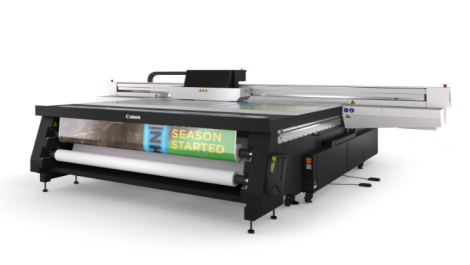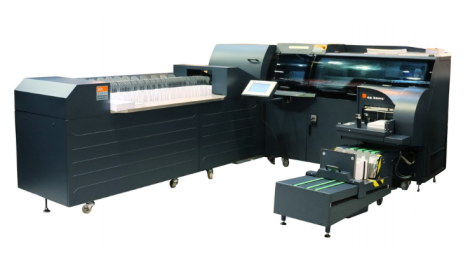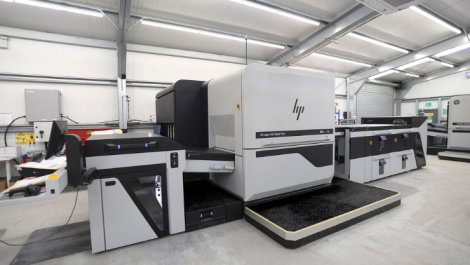Hybrid’s scheme for recycling solvent ink cartridges in exchange for free ink has been running since 2008
Environmental concerns haven’t typically been top of the agenda in wide-format but there is customer pressure for greener print and manufacturers are responding. Michael Walker went looking for the green shoots.
In some ways it’s misleading to view wide-format print as one category since it embraces so many different applications, printing technologies, ink types and substrates. So it’s perhaps not surprising that sustainability across the sector – if it is one and not several – isn’t viewed in quite the same way that it is in commercial print, where topics such as paper recycling and de-inking have attracted attention and concerted effort for decades.
The push for greener wide-format print comes from end-customers and increasingly the public. Brand owners are increasingly keen to promote themselves as environmentally responsible, especially in the light of recent revelations about the extent to which plastics have permeated the planet’s ecosystems.
‘We’re getting demands more often, pushed by the retail sector,’ says Andrew Simmons, sales director at Soyang Europe. ‘Store outlets are more interested in recycling and PVC-free options.’
Armando Mota da Silva, business development director at Portuguese manufacturer Digidelta, agrees: ‘Since the arrival of latex print, sustainability has become a topic, even for those using self-adhesive materials. Customers are sensitive to this and request PVC-free.’
There is a good story to tell for wide-format, though it’s taken a while to write it. Peter Davidson, senior business development director at Inktec, recalls how the brands, particularly the big supermarket chains, pushed for more environmentally friendly print production 10 or 12 years ago but ultimately weren’t prepared to bear the additional costs that greener materials and working practices entailed. ‘They tried to replace plastics with corrugated but the ink receptivity and durability were not as good and the prices were substantially higher,’ he recalls.
Since then, there have been a number of developments in substrates, application options and print technologies which have helped to give environmentally better decisions more financial allure as well as addressing quality issues. There’s no silver bullet that fixes everything, but a host of incremental improvements do add up.
Ink and printing technology choices affect the working environment for operators and have a bearing on the carbon footprint of the production process. Latex ink still takes more drying than LED UV alternatives, for example (though HP says allowing for production speeds its latest cost per printed square metre is similar or lower), dye-sublimation printers need heat presses, and any kind of solvent print still has to be left to outgas. But with current concerns over plastics, the bigger issue is perhaps what happens to it all after it’s been taken down?

Board and lodging: Dispa from Antalis is made of 100% recyclable FSC-certified paper
Is there an afterlife?
As with any carbon footprint calculations, the more of the entire product lifecycle you can measure or estimate, the more accurate your assessment of the true impact of the activity will be. That means thinking about what happens to the print after it’s served its purpose.
While paper-based products – posters and corrugated PoS displays, for example – may be sent to recycling streams established for other types of print (though it’s by no means a given that they are), other common media offer a range of recycling options, from almost none for vinyl, to quite a high level of potential for re-use for the same purpose with polyester-based fabrics and some plastics.
Polyester-based fabrics can be recycled and the quality and colour saturation achievable with these, particularly with dye-sublimation printing, has improved considerably in recent years to the point where they can provide a viable alternative in backlit applications. Fabrics also have environmental advantages for transport and storage.
Inktec’s Peter Davidson sounds a note of caution on the recycling claims, however: ‘Polyester and polypropylene are multiply recyclable if they’re clean but the minute you “poison” them with ink it’s no longer the same.’
Vinyl, or polyvinyl chloride, to give its full name, has by contrast been seen as the bad guy by environmentally-aware printers and customers because it hasn’t so far been possible to recycle it and PVC-free alternatives have typically been more expensive, offer inferior performance – or both.
This problem is under attack now from a couple of directions. Digidelta, which manufactures the Decal range of PVC- and solvent-free substrates, has invested heavily in production facilities in central Portugal, taking advantage of cheaper land and labour costs, plus some volume buying of raw materials which are sourced from within Europe, to offer its products at prices comparable to vinyl alternatives.
‘It’s a challenge to substitute for PVC – PVC-free is usually twice the cost. It’s been a huge effort,’ says Armando Mota da Silva. The Decal range has coatings that allow (HP certified) latex and UV printing and is Greenguard certified but Mr Mota da Silva doesn’t see any reason to pursue the solvent market, saying, ‘Latex covers more than 30% of the small roll-to-roll machines. We expect in the near future that solvent machines will tend to disappear.’ He also reports that a PVC-free wallcovering stock and range of textured films will be released shortly. ‘This is just the starting point without PVC,’ he says.
Recycling vinyl
The PVC problem has been addressed head-on by Soyang Europe, which is in the process of establishing a vinyl recycling facility that should be in operation within the next couple of months. The company isn’t saying too much just yet about exactly how this will operate – there are logistical and business issues around collecting the used material from installation sites, among other challenges – but Mr Simmons does confirm that the reclaimed vinyl will be ground up and processed into lower-grade materials for other. ‘Vinyl is still the best substrate for ink receptiveness and durability; this gives customers a solution,’ he says, adding that the new process will be traceable and certifiable.
One of the problems in attempting to recycle finished print materials is gathering them and then separating the different components. HP’s global textiles brand strategist Carlos Lahoz reports that a programme that the company ran in the US was not a great success not least due to the complexity of separating the constituent materials. Inktec’s Peter Davidson goes further, suggesting that deconstructing expired installations may be as environmentally unfriendly as throwing them away.
A recycled PVC-free film is available from Lintec. Re-Pop RE5055 is a clear lightweight dry-apply film aimed at POS and retail applications for short-term promotional campaigns and is Lintec’s first film to be manufactured with a minimum of 80% recycled PET material. Lintec says the film is durable, offers improved see-through and dimensional stability qualities and is easy to apply. The film’s paper release liner means that it can be used for UV digital as well as screen and litho print.
PVC-free films are available from a number of suppliers including 3M, whose Envision 48 and 48C ranges can be printed via solvent, UV or latex digital printing. 3M technical specialist Tim Beyer said, ‘There was a time when using these products meant sacrificing quality. However, through continuous research and innovation, 3M has turned the tables on this … we believe high-performance non-PVC films are the future of the intermediate graphics market.’ The Envision films are said to be suitable for a wide range of indoor and outdoor applications, from exhibition graphics and corporate signage to fleet graphics and other partial vehicle wraps.
For rigid print applications, Antalis offers Priplak, which is available in a 100% recycled post-industrial version as well as being multiply recyclable itself. Suitable for retailers with a high rate of signage turnover, it’s free from halogens, chlorine and plastifiers and can be printed digitally as well as via litho or screen processes.
Another display product with green credentials from Antalis is Dispa, which is a sign and display board for short-term indoor displays. Made entirely of cellulose fibre, Dispa has embossed internal layers for stability and flatness while being 100% recyclable FSC-certified paper. It’s described as having to have a smooth, bright-white printable surface and works with UV digital printers.
Mimaki distributor Hybrid operates a solvent ink cartridge recycling scheme. Called “Let’s Do More”, it’s been running for 10 years now and rewards customers for helping in recycling cartridges by giving them free ink. The returned cartridge parts are recycled or repurposed into other products and waste ink disposed of responsibly, at Hybrid’s cost. Hybrid’s national sales manager John de la Roche commented, ‘Solvent printing is still a very popular choice so the scheme offers a way of delivering a real-world solution to a real-world problem. The majority of our customers are signed up, it’s a case of small actions adding up.’
Another option is to reconsider the type of printed product. Fabric is increasingly being used for display graphics, including backlit types, and brings advantages in packaging and transport costs and related emissions as well as leaving a more recyclable waste product at the end of its life. Soyang’s Andrew Simmons says, ‘The retail and exhibitions sectors produce frightening amounts of waste; we’ve seen massive growth here in the last 18 months.’
Textiles don’t suit everything, of course. Mr de la Roche at Hybrid points out that glossy solvent ink on vinyl isn’t about to disappear for vehicle wraps, for example, but with more effort going into PVC-free alternatives that have established recycling routes, plus at least one attempt to recycle vinyl itself, the issue is becoming less about the technology and processes and more about the will to use them.





